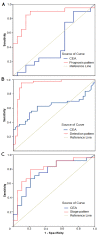Mining novel biomarkers for prognosis of gastric cancer with serum proteomics
- PMID: 19740432
- PMCID: PMC2753349
- DOI: 10.1186/1756-9966-28-126
Mining novel biomarkers for prognosis of gastric cancer with serum proteomics
Abstract
Background: Although gastric cancer (GC) remains the second cause of cancer-related death, useful biomarkers for prognosis are still unavailable. We present here the attempt of mining novel biomarkers for GC prognosis by using serum proteomics.
Methods: Sera from 43 GC patients and 41 controls with gastritis as Group 1 and 11 GC patients as Group 2 was successively detected by Surface Enhanced Laser Desorption/ionization Time of Flight Mass Spectrometry (SELDI-TOF-MS) with Q10 chip. Peaks were acquired by Ciphergen ProteinChip Software 3.2.0 and analyzed by Zhejiang University-ProteinChip Data Analysis System (ZJU-PDAS). CEA level were evaluated by chemiluminescence immunoassay.
Results: After median follow-up periods of 33 months, Group 1 with 4 GC patients lost was divided into 20 good-prognosis GC patients (overall survival more than 24 months) and 19 poor-prognosis GC patients (no more than 24 months). The established prognosis pattern consisted of 5 novel prognosis biomarkers with 84.2% sensitivity and 85.0% specificity, which were significantly higher than those of carcinoembryonic antigen (CEA) and TNM stage. We also tested prognosis pattern blindly in Group 2 with 66.7% sensitivity and 80.0% specificity. Moreover, we found that 4474-Da peak elevated significantly in GC and was associated with advanced stage (III+IV) and short survival (p < 0.03).
Conclusion: We have identified a number of novel biomarkers for prognosis prediction of GC by using SELDI-TOF-MS combined with sophisticated bioinformatics. Particularly, elevated expression of 4474-Da peak showed very promising to be developed into a novel biomarker associated with biologically aggressive features of GC.
Figures






Similar articles
-
Five serum proteins identified using SELDI-TOF-MS as potential biomarkers of gastric cancer.Jpn J Clin Oncol. 2010 Apr;40(4):336-42. doi: 10.1093/jjco/hyp175. Epub 2010 Jan 20. Jpn J Clin Oncol. 2010. PMID: 20089528
-
Diagnostic application of serum proteomic patterns in gastric cancer patients by ProteinChip surface-enhanced laser desorption/ionization time-of-flight mass spectrometry.Int J Biol Markers. 2007 Oct-Dec;22(4):281-6. doi: 10.1177/172460080702200407. Int J Biol Markers. 2007. PMID: 18161659
-
Application of serum SELDI proteomic patterns in diagnosis of lung cancer.BMC Cancer. 2005 Jul 20;5:83. doi: 10.1186/1471-2407-5-83. BMC Cancer. 2005. PMID: 16029516 Free PMC article.
-
SELDI-TOF serum proteomics and colorectal cancer: a current overview.Arch Physiol Biochem. 2010 Oct-Dec;116(4-5):188-96. doi: 10.3109/13813455.2010.495130. Epub 2010 Jul 8. Arch Physiol Biochem. 2010. PMID: 20615064 Review.
-
Advances in Molecular Biomarkers for Gastric Cancer.Crit Rev Eukaryot Gene Expr. 2015;25(4):299-305. doi: 10.1615/critreveukaryotgeneexpr.2015014360. Crit Rev Eukaryot Gene Expr. 2015. PMID: 26559090 Review.
Cited by
-
Coronin-1C is a novel biomarker for hepatocellular carcinoma invasive progression identified by proteomics analysis and clinical validation.J Exp Clin Cancer Res. 2010 Feb 24;29(1):17. doi: 10.1186/1756-9966-29-17. J Exp Clin Cancer Res. 2010. PMID: 20181269 Free PMC article.
-
Advances in molecular biomarkers for gastric cancer: miRNAs as emerging novel cancer markers.Expert Rev Mol Med. 2014 Jan 23;16:e1. doi: 10.1017/erm.2013.16. Expert Rev Mol Med. 2014. PMID: 24456939 Free PMC article. Review.
-
Identification of Kininogen 1 as a Serum Protein Marker of Colorectal Adenoma in Patients with a Family History of Colorectal Cancer.J Cancer. 2018 Mar 8;9(3):540-547. doi: 10.7150/jca.22405. eCollection 2018. J Cancer. 2018. PMID: 29535795 Free PMC article.
-
Serum profiling by mass spectrometry combined with bioinformatics for the biomarkers discovery in diffuse large B-cell lymphoma.Tumour Biol. 2015 Mar;36(3):2193-9. doi: 10.1007/s13277-014-2830-z. Epub 2014 Nov 20. Tumour Biol. 2015. PMID: 25409615
-
Development of a two-circular RNA panel as potential prognostic biomarker for gastric cancer.J Transl Med. 2021 Oct 2;19(1):412. doi: 10.1186/s12967-021-03075-y. J Transl Med. 2021. PMID: 34600555 Free PMC article.
References
Publication types
MeSH terms
Substances
LinkOut - more resources
Full Text Sources
Medical
Miscellaneous

